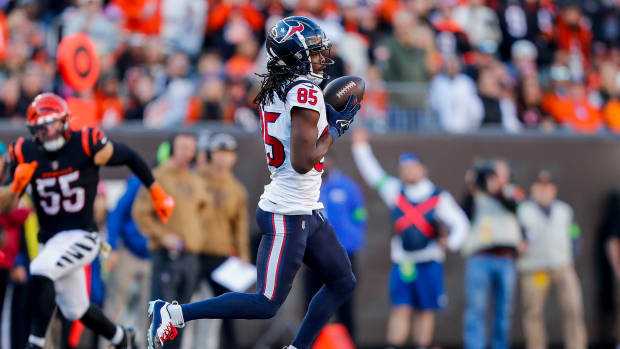Limiting 'Explosives' Helps Ohio State Defense Blow Up Opponents
The toughest tests for Ohio State's defense await later in the season, but the midterm report card makes a convincing case for the elimination of the Buckeyes' chief deficiency from a year ago.
Entering an 8:30 p.m. Friday kickoff at Northwestern, No. 3 OSU has allowed just four plays of 30 yards or more, which is tied for the fewest such gains allowed by any team in the country.
Last season, OSU ranked 95th in the country on plays gaining 20 yards or more.
"No defense wants to give up big plays," Ohio State coach Ryan Day said. "I think we’ve done a good job of teaching where everybody fits into the defense....Guys understand where everybody is on the field. And so if you know where everybody is, when you go to track the ball, I think that’s important.
"You can play with a little bit more confidence knowing maybe you’re not on an island, you have guys that are coming with you, swarming to the ball, and I think that’s helped."
Granted, the Buckeyes' half-dozen opponents so far haven't reminded anyone of the Greatest Show on Turf.
Indiana ranks 44th nationally in total yards per-game and is the highest-ranked offense to face OSU. The Hoosiers did so with dual-threat starting quarterback Michael Penix -- their main weapon -- sidelined by injury.
Otherwise, Ohio State has played Florida Atlantic (68), Nebraska (76), Cincinnati (79), Michigan State (100) and Miami of Ohio (129).
Northwestern (125) fits right into that collection of motley offenses, having produced a Big Ten-low nine plays of 20 yards or more so far.
But is the Buckeyes' defense simply the beneficiary of playing bad offenses, or are those offenses well down in the NCAA team rankings because they played OSU and found no room to operate?
Future games against Wisconsin (38) and Penn State (28) will provide greater clarity, but it was routine for bad teams to make Ohio State look bad defensively a year ago.
In the Big Ten title game against a Northwestern offense that finished 2018 12th in the 14-team Big Ten and 101st in the nation, OSU allowed:
- a 77-yard touchdown run from John Moten IV that tied the game, 7-7.
- four consecutive plays of 15 yards or more to feed a 64-yard Northwestern touchdown drive to start the third quarter, eating into OSU's 24-7 halftime lead.
- an 11-play, 85-yard TD drive on Northwestern's next possession that included a 20-yard run and pass plays of 16 and 17 yards that brought the Wildcats within 24-21.
Day watched all that and, by the time the Buckeyes played again in the Rose Bowl, knew he would be taking over for Urban Meyer as head coach in 2019.
Pass rush gives Ohio State leg up on stopping opponents
As an offensive specialist himself, Day knew what problems defenses presented him as a play-caller. He also knew he had veteran defensive line coach Larry Johnson and a stable of outstanding pass-rushers, led by junior Chase Young, coming back for this season.
That led him to establish parameters for the foundation he wanted his defense built upon -- four down linemen -- but beyond that he left the specifics to new co-coordinators Jeff Halfley and Greg Mattison.
Halfley, Day had worked with in the NFL during a two-year stint with the San Francisco 49ers.
Mattison seemed an odd fit, given his resume featuring two different stays at Michigan, another at Notre Dame and the fact he was Florida's defensive coordinator when the Gators throttled Heisman Trophy-winner Troy Smith and a previously high-powered OSU offense in the 2007 BCS Championship Game, holding the Buckeyes to a just 82 yards total offense in a 41-14 upset.
Results last year convinced Day changes had to be made
The results, though, have been undeniable, given that OSU in 2018 allowed eight plays of 60+ yards, seven plays of 70+ yards, four plays of 80+ yards and two plays of 90+ yards.
No wonder Hafley is obsessed with eliminating those sorts of gains.
“The number one thing we talk about when we put in new calls, when we talk about anything — and we say it over and over again — is we want to eliminate explosives,” Hafley said. "If we think a blitz is really, really good, but there’s potential for it to give up an explosive, we’re not going to put it in.
"If we feel like there’s a really, really good coverage that say we want to run on third and 4-to-6, and we really like it against what they’re doing, but there’s a chance to give up an explosive, we’re not going to do it.
“Everything we think about, we think about explosives, because our whole philosophy is, we want to make you drive the length of the field. If you can drive on us the length of the field and then put it in the end zone against us in the red zone, nice job. Then we’ve got to figure out why and we’ve got to adjust some things.”
Wisconsin (38th in total offense) and Penn State (28th) will test that theory more than any previous OSU opponents, but the truest measure of the Buckeyes' improvement probably won't come until the College Football Playoff when the opposition could include Alabama (6), Clemson (12), LSU (2) or Oklahoma (1).





